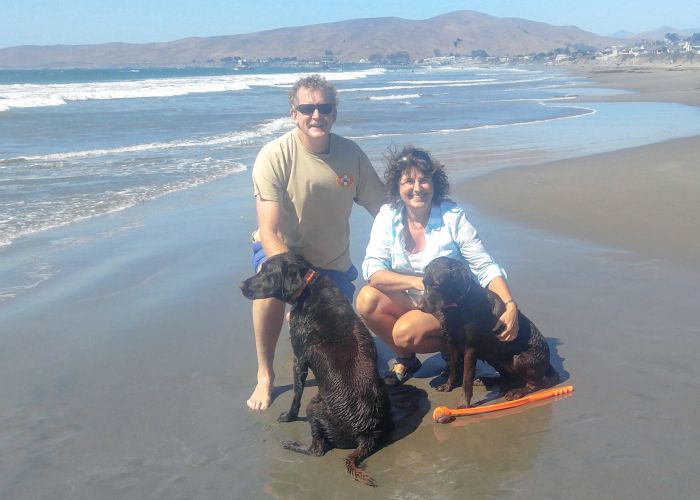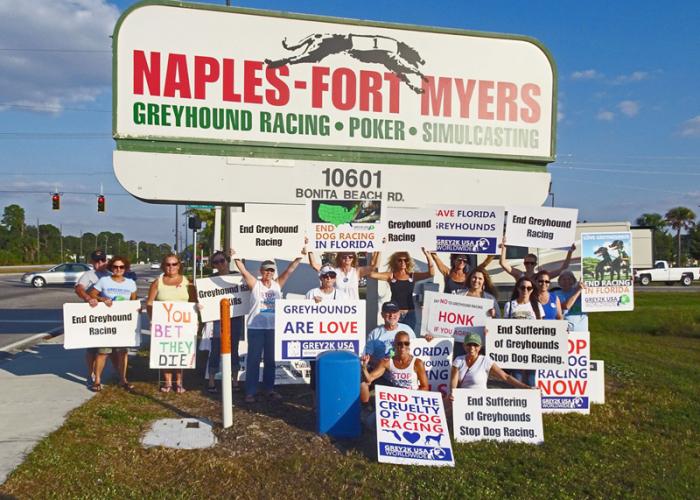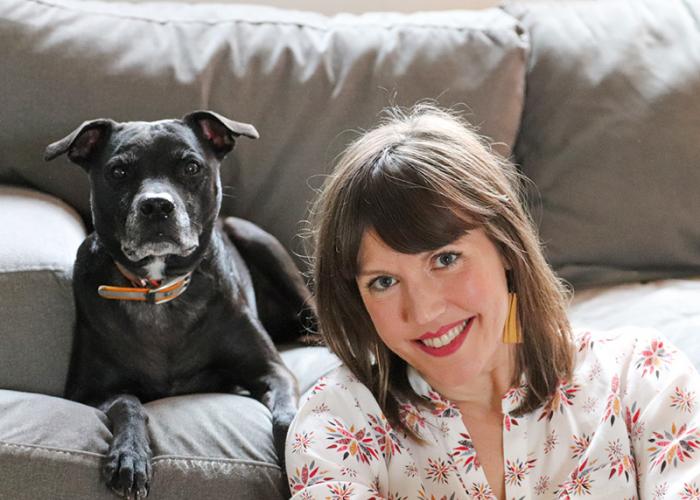Hope for the hardest cases
Rehab of dogs from a South Korean meat farm has lessons for anyone handling traumatized animals
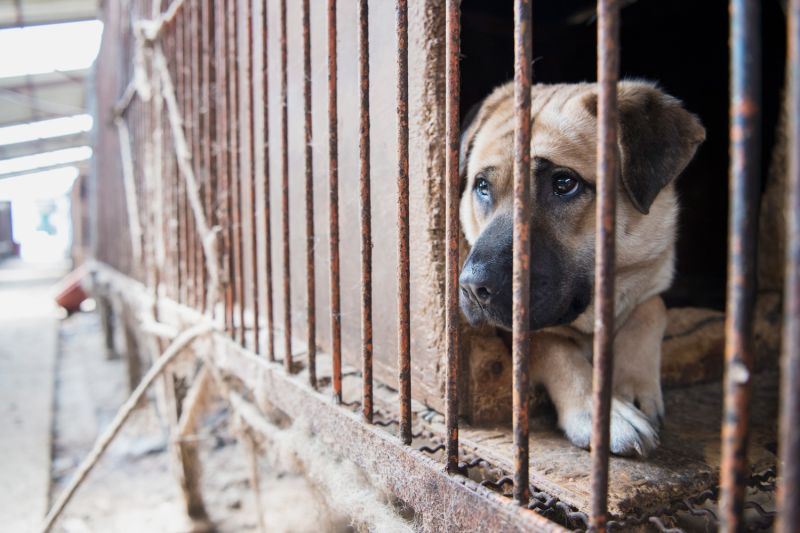
They’re enough to break your heart, those dogs who cower nonstop in the back of their kennel or gator roll with the slightest pressure of a leash. Or perhaps they snarl or pancake to the ground when approached. Experienced animal welfare people know these behaviors are often signs of past abuse or neglect. Some dogs are so unsocialized that they snap at or shrink from human touch.
Take the case of Bryant, a white Jindo mix who spent several years living in a wire cage on a South Korean dog-meat farm before being rescued by Humane Society International (an HSUS affiliate). He screamed and wailed at even the gentlest touch after arriving at St. Hubert’s Animal Welfare Center in New Jersey, an HSUS emergency placement partner.
St. Hubert’s, which took 11 of the 250 dogs transported to the United States in April, uses a variety of techniques to help rehabilitate the most shut-down dogs, giving them a chance at normal lives.
The South Korean dogs were pretty skittish, remembers Becky Burton, who oversees animal care at the shelter. “Even direct eye contact scared Bryant.”
Bryant had been confined long term. He was unsocialized and had been handled roughly. He’d also likely witnessed cruelty toward dogs around him.
Fortunately, dogs are resilient. And healing is possible, even in some of the toughest cases.
Road to emotional rehab
The rough treatment Bryant experienced at the dog-meat farm may seem far from what most American shelter dogs have been through. But it was in many ways similar to that experienced by dogs in puppy mills, fighting operations and egregious abuse or neglect cases.
Rehabilitation is about meeting basic needs, creating a safe and comfortable living space and working patiently to build trust. It’s observing behavior to better understand a dog’s likes and dislikes, his motivations and fears.
Burton put Bryant in her office, where it was quiet. This gave him an opportunity to chill out around someone who was nice to him but not so focused on him that it made him uncomfortable. Burton tossed him treats sometimes, which he’d eat when she left the room.
Within a week, Bryant was eating in her presence. The next week he was taking food from her hand. That bond of accepting food from his new friend laid the foundation for recovery.
Burton also did things like not looking at Bryant straight on and turning to the side and squatting down whenever she approached. The strategies, she says, made her appear less scary. She’d stroke him on the cheek and say “good boy” when he accepted food from her hand or rub his chest if he leaned in. “But never going over the top of his head, which is intimidating for dogs,” she says.
Volunteers would come into her office and toss him treats to build on his positive experiences with people. A baby gate separated her office from the rest of the shelter, allowing him to take in all the activity. But he also had a crate where he could retreat if something frightened him.
Odd as it may sound, Bryant’s first big success came when he shredded his pee pads overnight. “That meant he was up investigating and curious about his surroundings,” Burton says, “that he wasn’t so shut down he stayed in his crate.”
The third week, she found the dozen or so stuffed animal toys she’d left in her office the night before had been moved around. “Then it was like a lightbulb went off,” she says. “He started play-bowing and bouncing around and coming over and leaning on me.” Bryant learned to walk on leash and play with other dogs. He loved throwing his toys in the air and collecting them around his bed.
In mid-May, less than a month after his rescue, Bryant was adopted.
Successes like that are hard to beat, Burton says.
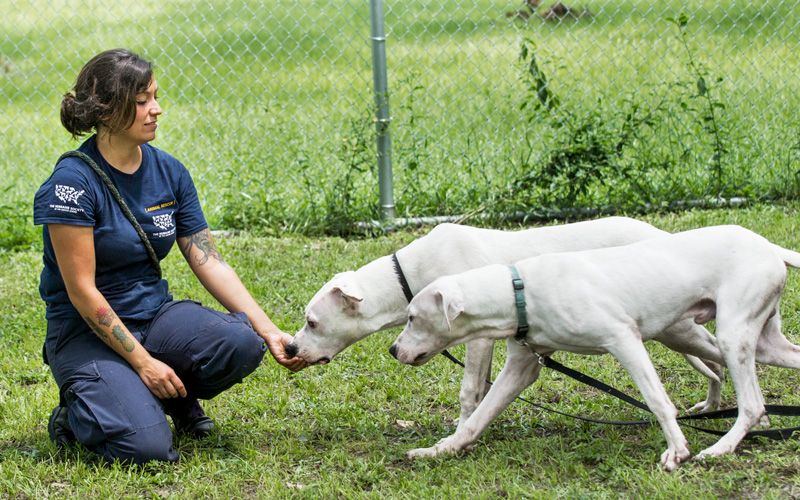
Routine and safe spaces
Recovery begins with routine, says HSUS shelter operations manager Gina Lantella, whose team helps care for animals immediately after rescues until they are transported to placement partners. Just knowing when people will be feeding them, cleaning their kennel and visiting with treats helps to relieve dogs’ stress, she says.
The dogs should have a comfortable living space. One easy way to cozy up their kennel is to watch for where they naturally sit or lie, Burton says. “That’s where you’ll want to put their bedding.” For added security, place a crate inside the kennel. “When a dog is hugging the back of their kennel, he might need to hide,” Lantella says.
Shelter operations manager Kari Vincent of the Norfolk SPCA in Virginia fashioned a homemade tent-bed for a little sheltie mix named Opossum who’d come in as a stray. “I’ve never seen a dog so terrified in my life,” she remembers. “He was completely undersocialized and would just flop over and play dead.” The tent gave Opossum a chance to retreat when he felt overwhelmed. “But he couldn’t completely disappear from us. He could see us and make eye contact.”
The bottom half of a crate or one with no door are also good options. Lantella’s team sometimes uses half crates with dogs who rely too much on hiding and need to develop coping skills. “The half crate still allows for some privacy and a bit of hiding, but it also encourages them to watch and learn since it’s no longer completely covered,” she says. “It’s like taking the training wheels off.”
Lantella remembers one South Korean rescue named Ferne who would growl and “whale-eye” when anyone ventured into her 5-by-5-foot kennel. “But just because a dog is growling at you doesn’t mean they want to hurt you,” she says. “We knew from her response that she needed more space. She needed to be able to get farther away from us to process what was happening to her.” Staff moved Ferne into a larger space, and within a couple of days she was approaching the front of the kennel and taking hand-delivered treats.
Something else that can help is observing dogs who are “talking” to each other, Lantella says, “like one dog might bark or howl, and after a couple of days you’ll notice who responds before the whole bunch starts to vocalize.” Connections like this occur with dogs who’ve never met as well as dogs who may have lived in close proximity before they were rescued. Placing these dogs close together, so they can at least see each other, can foster a sense of comfort.
Trust-building exercises
When you’re dealing with fearful dogs, seemingly small details matter. Lantella’s team conducts what they call “roll-bys,” which involve walking by the dog’s kennel, tossing in treats and saying a few kind words. It’s simple enough, but team members have to be conscious about how they walk: An overly slow pace can freak out the dogs (who perhaps interpret it as stalking behavior), while moving too fast can agitate them. So they roll by at a medium-paced, casual speed.
Sometimes the team plays classical music or sprays lavender in the kennel’s front corner for a calming effect. Staff might also sit in front of the kennel a couple of times a day to just spend time with the dog, talking softly and tossing in treats. “The dogs see other dogs approaching the front of their kennel and getting rewarded,” Lantella says, “and they learn from each other.”
Staff should move at the dog’s pace with each new thing. “Sometimes people make the mistake of doing too many things at once, which can be overwhelming for a dog who has been, say, neglected or abused,” says Kristi Jackson of the Peggy Adams Animal Welfare League in West Palm Beach, Florida. “It’s often just one small thing at a time that these dogs can handle. Simple kindnesses, small steps. And then as far as training, you just start with one thing and once they get really good at that thing, you add something else if you can.”
Even simple activities—putting on a collar and leash, walking on leash, playing with toys—take time. Lantella remembers the dozens of Dogo Argentinos whom The HSUS sheltered for nearly a year after rescuing them from a suspected hog-dog fighting operation in rural Alabama. “It wasn’t as simple as putting a leash on these guys and training them. They didn’t even know what a leash was.”
The team started with activities like “leash on/leash off,” which helped acclimate them to the feel of the leash. “For some dogs, teaching them to walk on leash starts with the pairing of treats with the sight of the leash,” she says. From there, the leash stays on for longer stints. Then it may be one or two steps of walking outside of the kennel, with rewards for even the smallest successes.
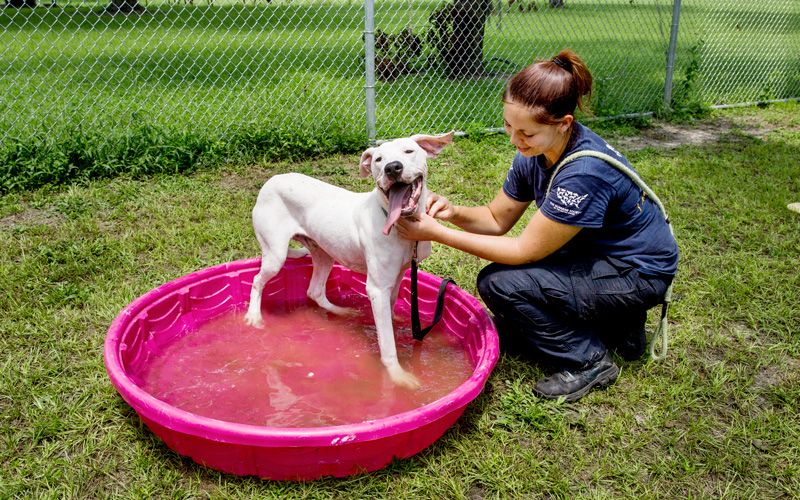
Enriching experiences
Identifying a dog’s likes and dislikes is part of the rehab strategy. “Every dog is different,” Vincent says, “and it’s important to observe their behavior to understand what ‘positive’ means for them individually.” At the Norfolk SPCA, staff cook up a variety of concoctions to see what tantalizes each dog’s taste buds. “We are obsessed with getting them to eat,” says Vincent.
One South Korean rescue named Brienne had a penchant for apples with peanut butter—but she’d only eat apples with the skin on. She also preferred eating directly from newspaper rather than a bowl. “We tried everything with her—plastic, a stainless steel bowl, in a paper tray—and it ended up being directly on newspaper,” Vincent says.
The Norfolk SPCA staff meets every week to formulate individualized enrichment plans, which weave in each dog’s preferences, even down to details such as a braided rope toy over one that’s knotted. One Dogo Argentino named Lucy loved to sit under a shade tree while a staff member read to her, which was included in her enrichment plan.
Play groups are an enrichment tool that not only socializes dogs to other dogs, but also facilitates trust toward humans. Barring any medical issues, “play group is something we almost immediately begin to employ,” Jackson says. “We’ll use a couple of stable dogs who are really good, and the anxious dogs learn by watching them come up to staff, showing that we aren’t anything to fear.”
One Dogo, who’d become attached to certain staff at an HSUS temporary shelter, shut down after those people shifted out of rotation. “She would retreat into her kennel,” Lantella says. “She wouldn’t eat in front of us or investigate her environment until we left.”
Staff paired her with a dog she seemed to like near her kennel. “Her reaction wasn’t immediate, but she did perk up,” Lantella says. Over the next weeks, she was introduced to other dogs in play group. Each visit brought significant improvement. “She was excited to be around her dog friends, and her confidence improved around people as she observed them coming up to us.”
As another enrichment activity, the staff at St. Hubert’s takes dogs on pack walks through a wooded area near the shelter.
“Everyone usually grabs their favorite dogs, and off we go,” Burton says. “It’s a great confidence builder.”
One huge mastiff mix named Darwin from South Korea did especially well. He’d started out as a barker and being pushy with staff. “The first time we took Darwin out, we couldn’t get him out of the stream. He rolled around in the water like a little kid, as silly as could be.” He was adopted soon after.
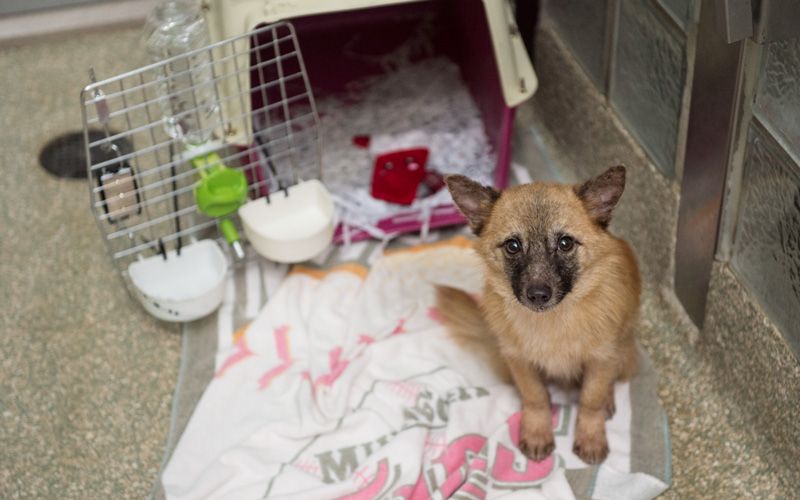
Redirecting trigger responses
Another rehab strategy is to redirect the dog’s attention from potential stressors. Take the case of Eve, whose previous owners admitted to holding her down and cutting off her ears. When she arrived at the Norfolk SPCA, “you could tell she had started out with a good life socially,” Vincent says. “She knew how to interact with people.”
But touching her in a certain way or holding a hand above her head would trigger meltdowns similar to post-traumatic stress disorder. “She would go into a defense mode and could be pretty dangerous,” Vincent remembers. Staff did lure coursing and scent work with her, having her chase a long lunge whip with a fuzzy toy attached, hiding treats in her bedding and placing a few drops of different veterinarian-approved essential oils in her kennel one day each week. “So we kind of overloaded her mind with things to do so she didn’t have the opportunity not to trust.”
For dogs unable to join a play group because they don’t do well with other dogs, staff at the Peggy Adams Animal Welfare League keep them busy with training programs that include bouncy balls, wobble boards and K9FITbone balancing platforms. The sessions begin simply, Jackson says. “We give them a [treat] if they even look at the wobble board or FITbone. If they walk toward it, they get paid. If they touch it with their nose, they get paid. But if [they] walk away, the rewards stop.”
“The training teaches them to focus and to use their brain and body,” says Jackson. “It teaches them how their actions cause something good. They like that and want to do it again.”
Helping traumatized dogs overcome their past isn’t difficult, Vincent says. But it is a process. Seeing each success, whether big or small, feels great. But even more than that is the profound joy that comes when these dogs are adopted. “To see them share that love and trust with another person, you know all that work was worth it.”


